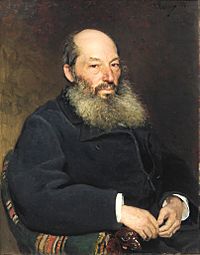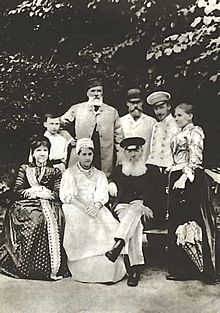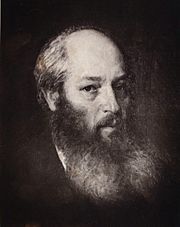Afanasy Fet facts for kids
Quick facts for kids
Afanasy Fet
|
|
|---|---|

Portrait by Ilya Repin
|
|
| Born | 5 December [O.S. 23 November] 1820 Mtsensk, Russian Empire |
| Died | 3 December 1892 (aged 71) Moscow, Russian Empire |
| Relatives | Vladimir Semenkovich |
| Signature | |
 |
|
Afanasy Afanasyevich Fet (Russian: Афана́сий Афана́сьевич Фет), later known as Shenshin (Russian: Шенши́н; 5 December [O.S. 23 November] 1820 – 3 December [O.S. 21 November] 1892), was a famous Russian poet. Many people consider him one of the best writers of lyric poetry in Russian literature.
Contents
Biography
Afanasy Fet was born on December 5, 1820. His father was Afanasy Shenshin, a Russian landowner. His mother was Charlotte Becker, a German woman. Shenshin met Charlotte in Germany and she decided to move to Russia with him. She was expecting her second child and divorced her first husband, Johann Foeth. She then married Shenshin.
However, their marriage, which was registered in Germany, was not legally valid in Russia. So, when Afanasy was fourteen, he had to change his last name from Shenshin to Foeth. This was a very difficult time for him. It was even harder because Johann Foeth, his biological father, did not accept him as his son.
Early Life and Education
When Afanasy was 14, he was sent to a German boarding school. It was there that he learned his name would be Fet, not Shenshin. He felt like he had lost his identity. In 1837, his stepfather moved him to a school in Moscow.
In 1838, Fet started studying law and language at Moscow University. He began writing poetry during his first year. He was inspired by poets like Goethe and Heine. He also became close friends with Apollon Grigoriev, another student who wanted to be a poet.
First Poems and Recognition
In the late 1830s, Fet showed some of his poems to a historian named Mikhail Pogodin. Pogodin sent them to the famous writer Nikolay Gogol. Gogol said Fet was "undoubtedly gifted," which encouraged Fet to publish his first collection, Lyric Pantheon, in 1840.
His work was praised by important critics like Vissarion Belinsky. Belinsky even said that Fet was "the most gifted" of the living Russian poets. In 1841, a poem called "Poseidon" was published under his full name. This was a big step for him.
From 1842 to 1843, Fet's poems were often printed in popular magazines. One of his poems, "Don't wake her up at dawn...", became a popular Russian song. Even though he was gaining recognition, Fet was often sad during these years. His friend Apollon Grigoriev said he was "tormented by depressions."
Military Service and Literary Connections
Fet graduated from university in 1844. The next year, he joined the Imperial Cuirassier regiment as a junior officer. He hoped that by serving in the army, he could get his family name and noble status back. He found army life difficult and felt isolated.
In 1848, Fet fell in love with Maria Lazich. She was a smart and educated young woman. Fet loved her too, but he was poor and couldn't see a way to marry her. So, he left her. Sadly, Maria died in 1851 in a tragic fire. Some people thought it was an accident, while others believed it was a desperate act. This event caused Fet great sadness and guilt for the rest of his life. Maria's image often appeared in his later poems.
In the late 1840s, Fet started writing again. In 1850, a collection called Poems by A. Fet marked his successful return to the literary world. In 1853, he moved to Saint Petersburg. During the Crimean War, he served guarding the Estonian coast.
In 1853, the famous writer Nikolai Nekrasov invited Fet to join Sovremennik, a popular magazine. There, he reunited with old friends like Ivan Turgenev and met Leo Tolstoy. Fet and Tolstoy became lifelong friends. Nekrasov greatly admired Fet's poetry.
In 1856, a new collection of Fet's poems came out. Nekrasov wrote in the book's introduction that Fet was an amazing poet. He said that "Not a single poet since Pushkin has managed to give such delight... as Fet does."
However, by 1856, Fet's friendship with Nekrasov became difficult because they had different ideas about poetry. Fet believed that art should be beautiful for its own sake, not just for social or moral messages. He left Sovremennik in 1859.
Life as a Landowner
In 1857, Afanasy Fet married Maria Petrovna Botkina in Paris. She was the daughter of a wealthy tea merchant and was known for being kind. In 1858, Fet left the army and moved back to Moscow.
A year later, he bought a large piece of land called Stepanovka in the Mtsensk region. In 1860, he moved there. Over the next fourteen years, he worked hard to turn the land into a successful farm. He grew crops, raised horses, and built a mill. His farming ventures were very profitable.
From 1867 to 1877, Fet also served as a local Justice of the peace. He was respected by both peasants and other landowners. His friend Leo Tolstoy, who also moved to the countryside around this time, approved of Fet's decision to live on the land. However, unlike Tolstoy, Fet stopped writing poetry for a while.
Later Years and Return to Poetry
In the 1860s, Fet translated some important works, including Aeneid and Arthur Schopenhauer's The World as Will and Representation.
In 1873, Fet's biggest wish came true. Tsar Alexander II allowed him to officially use his stepfather's surname, Shenshin. This also gave him back all the rights and privileges of Russian nobility. Even though he was now officially Shenshin, the poet continued to use Fet as his pen name.
In 1873, Fet bought a second village, Vorobyovka, near Kursk. This is where his passion for writing poetry returned. He wrote to Grand Duke Konstantin Romanov in 1891, saying that his muse (his inspiration) had woken up at Vorobyovka.
In 1881, Fet bought a small house in Moscow. From then on, he would spend winters in the city and summers at Vorobyovka. This new burst of creativity led to four books in his Evening Lights series, published between 1883 and 1891. These books contained some of his best work.
Even though his new poems were beautiful, they didn't sell well. Only a small group of close friends, including Leo Tolstoy, Vladimir Solovyov, and Pyotr Tchaikovsky, truly appreciated them.
In 1890, Fet published two volumes of his memories called My Memories: 1848–1889. Another book, My Early Years, was published after he passed away. In 1892, a big event was held in Moscow to celebrate 50 years of Fet's writing career.
Death
Afanasy Fet passed away on December 3, 1892. He had moved to his Moscow house in October. After visiting a friend, he caught a cold and developed severe bronchitis. The cause of his death was later said to be a heart attack. His funeral was held on November 22, 1892, and he was buried in his family vault in Kleymyonovo.
Legacy
Today, Afanasy Fet is considered one of Russia's greatest lyric poets. His poems were highly valued by critics like Vissarion Belinsky. The poet Osip Mandelstam even called Fet the greatest Russian poet of all time.
Fet's poetry often showed deep feelings, sadness, and beauty. He had a strong influence on later Russian poets, especially the Russian Symbolists like Innokenty Annensky and Alexander Blok. Blok even called Fet his "great teacher." Other poets influenced by Fet include Sergey Yesenin and Boris Pasternak.
Even though he is highly regarded now, Fet was not very popular during his lifetime. One reason might have been that he didn't change his style to fit the popular ideas of his time. He focused on pure art and beauty, while many other writers were focused on social issues.
Fet's Ideas on Art
Fet believed that a poet should separate life into two parts: the 'ideal' and the 'real'. He thought that only the 'ideal' part allowed people to experience a higher kind of life. This ideal part included beauty, love, and moments when the human soul felt connected to the universe. Art itself was part of this ideal world.
Fet believed that true art should serve 'pure love' and beauty. While these ideas were popular in the 1840s, Fet found himself alone in these beliefs by the 1860s, when most writers were focused on realistic stories.
Fet also thought that understanding nature helped people connect with the world around them. He grouped his poems into cycles like "Spring," "Summer," and "Snow." Each cycle explored different feelings and the idea of becoming one with nature. He believed that connecting with nature brought people great joy and happiness.
Political Views
Afanasy Fet was known for thinking for himself. He wasn't easily labeled as a liberal or a conservative. He had his own ideas and wasn't afraid to speak them, even if they went against what most people believed.
Fet also believed in the importance of hard work and "civil labor." He thought that a natural approach to work was like love, helping people connect with nature and bring harmony back to society. He believed in the freedom of individuals to develop their own character and warned against too many rules in society.
Personality
His friend Yakov Polonsky often wondered about Fet's two sides. On one hand, Fet was a practical, down-to-earth person. On the other hand, he created beautiful, ideal, and youthful poetry. Polonsky wrote that Fet seemed to have an unseen, young, believing side that loved life, even as the older Fet might deny things or seem to despise life.
People in the countryside admired Fet. They called him a "proper kind of landlord" because he was honest and direct with everyone, including peasants. He was respected for his ability to help solve problems in his community.
Fet was a private person and became even more so over the years. He didn't often show interest in other people's inner feelings. Even though Pyotr Ilyich Tchaikovsky thought Fet was "more a musician than a poet," Fet himself was said to be "indifferent to music" and sometimes called it "unpleasant noise."
While Leo Tolstoy's children found Fet a bit difficult, Tolstoy himself greatly admired him. Tolstoy wrote that they understood each other because they both thought with their "heart's mind" rather than just their "brain's mind." He also said that Fet was intellectually superior to others around him and could offer a "different kind of bread" for his mind.
Sample
I Have Come to You, Delighted («Я пришёл к тебе с приветом…»)
- Я пришёл к тебе с приветом,
- Рассказать, что солнце встало,
- Что оно горячим светом
- По листам затрепетало;
- Рассказать, что лес проснулся,
- Весь проснулся, веткой каждой,
- Каждой птицей встрепенулся
- И весенней полон жаждой;
- Рассказать, что с той же страстью,
- Как вчера, пришёл я снова,
- Что душа всё так же счастью
- И тебе служить готова;
- Рассказать, что отовсюду
- На меня весельем веет,
- Что не знаю сам, что́ буду
- Петь — но только песня зреет.
- I have come to you, delighted,
- To tell you that sun has risen,
- That its light has warmly started
- To fulfil on leaves its dancing;
- To tell you that wood's awaken
- In its every branch and leafage,
- And with every bird is shaken,
- Thirsty of the springy image;
- To tell you that I’ve come now,
- As before, with former passion,
- That my soul again is bound
- To serve you and your elation;
- That the charming breath of gladness
- Came to me from all-all places,
- I don't know what I'll sing, else,
- But my song's coming to readiness.
See Also
 In Spanish: Afanasi Fet para niños
In Spanish: Afanasi Fet para niños







